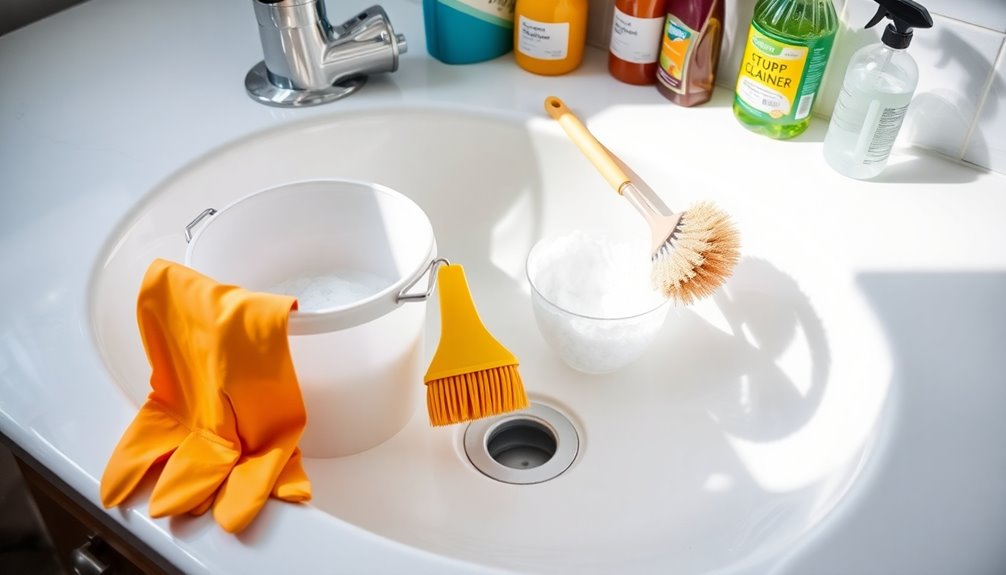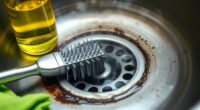To clean a utility sink, start by removing debris from the dry sink. Scrape stubborn dirt with a putty knife, then create a paste using Bar Keepers Friend and water. Use 0000 grade steel wool to scrub in circles, then rinse thoroughly with warm water. Wipe with a microfiber cloth for shine. Don't forget about ongoing maintenance to keep your sink in top shape. There's plenty more to discover about effective cleaning strategies!
Key Takeaways
- Start by removing loose debris and scraping off stubborn stains using a putty knife for an initial clean slate.
- Create a paste with Bar Keepers Friend and water, applying it to the sink for effective stain removal.
- Use 0000 grade steel wool to scrub the sink in a circular motion, ensuring thorough cleaning without damaging the finish.
- Rinse the sink thoroughly with warm water, repeating the process for any heavily soiled areas as needed.
- Wipe down the sink with a microfiber cloth for a polished finish and establish a regular cleaning schedule to maintain cleanliness.
Understanding the Importance of Utility Sink Cleaning
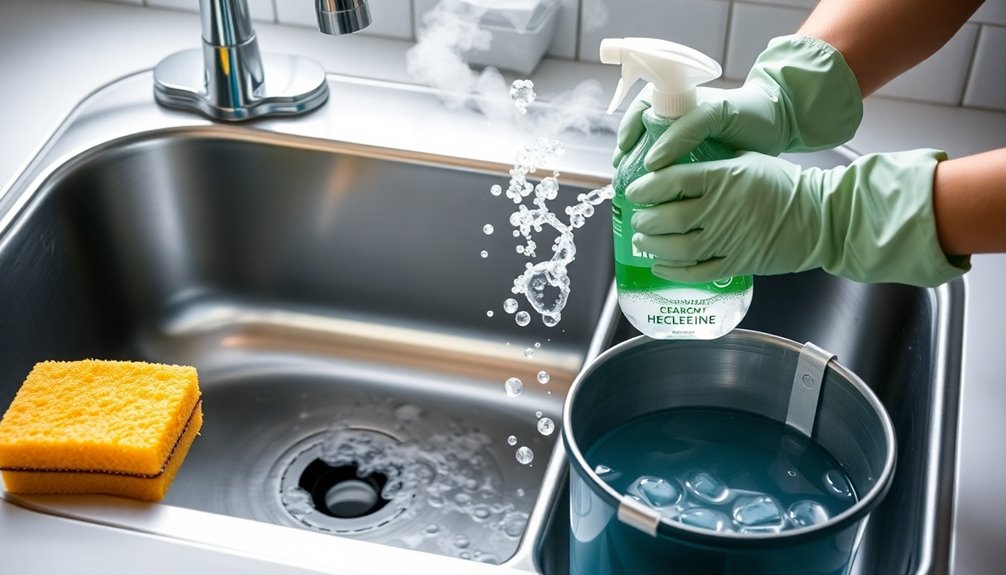
While it might seem easy to overlook, cleaning your utility sink is essential for maintaining a hygienic and functional space. Regular cleaning prevents grime, soap scum, and debris from accumulating, which can create unsanitary conditions and unpleasant odors.
By prioritizing maintenance, you reduce the risk of clogs caused by residues from chemicals, detergents, and dirt, ensuring proper drainage and plumbing health.
Moreover, a clean utility sink minimizes the growth of mold, mildew, and bacteria, promoting a healthier environment in areas like your laundry room or garage.
Neglecting to clean it can lead to permanent stains and damage, ultimately shortening the sink's lifespan.
Consistent cleaning not only helps remove stains but also enhances the sink's effectiveness for heavy-duty tasks.
Essential Cleaning Supplies Needed

To clean your utility sink effectively, you'll need the right supplies on hand.
Gather cleaning products like Bar Keepers Friend and some protective gloves to keep your hands safe.
It's also smart to have a scrub brush or sponge ready for those tougher spots.
Recommended Cleaning Products
When cleaning a utility sink, having the right products makes all the difference. Start with Bar Keepers Friend, which is excellent for removing stains, rust, and buildup without scratching the surface.
For tougher stains, use a 0000 grade steel wool; it's gentle enough to preserve your sink's finish. A scrub brush can help distribute cleaning products effectively, ensuring you cover all areas.
For stubborn residue, a putty knife works wonders before you apply any cleaning solutions. If your sink is heavily soiled, mix the powdered version of Bar Keepers Friend with water to create a paste for deep cleaning.
Don't forget to wear gloves to protect your hands during the cleaning process.
Safety Precautions
Before diving into cleaning your utility sink, it's crucial to prioritize safety. Always wear gloves to protect your hands from harsh cleaning chemicals and grime.
When using strong cleaners, guarantee proper ventilation to avoid inhaling harmful fumes, especially with products like Mineral Spirits or oven cleaners.
Keep your cleaning supplies organized and accessible, including Bar Keepers Friend, steel wool, and putty knives, to streamline the process.
Be cautious—never mix different cleaning agents without confirming compatibility, as this can lead to dangerous reactions or harmful gas release.
Finally, test any new cleaning method or product on a small, inconspicuous area of the sink first to verify it won't damage the surface.
Following these safety precautions will help you clean effectively and safely.
Step-by-Step Cleaning Process

Cleaning a utility sink can be straightforward if you follow these simple steps.
Start by scraping off any excess dirt and stains with a putty knife to prepare the surface.
Next, apply a generous amount of Bar Keepers Friend Soft Cleanser, mixing it with a little water to create a paste.
Use 0000 grade steel wool to scrub the sink in a circular motion, watching for the suds to turn brown, which means you're removing dirt effectively.
Rinse the sink thoroughly with warm water afterward.
If some heavily soiled areas remain, repeat the process as needed.
This method will help guarantee your utility sink looks clean and fresh, ready for your next task.
Tackling Tough Stains Effectively
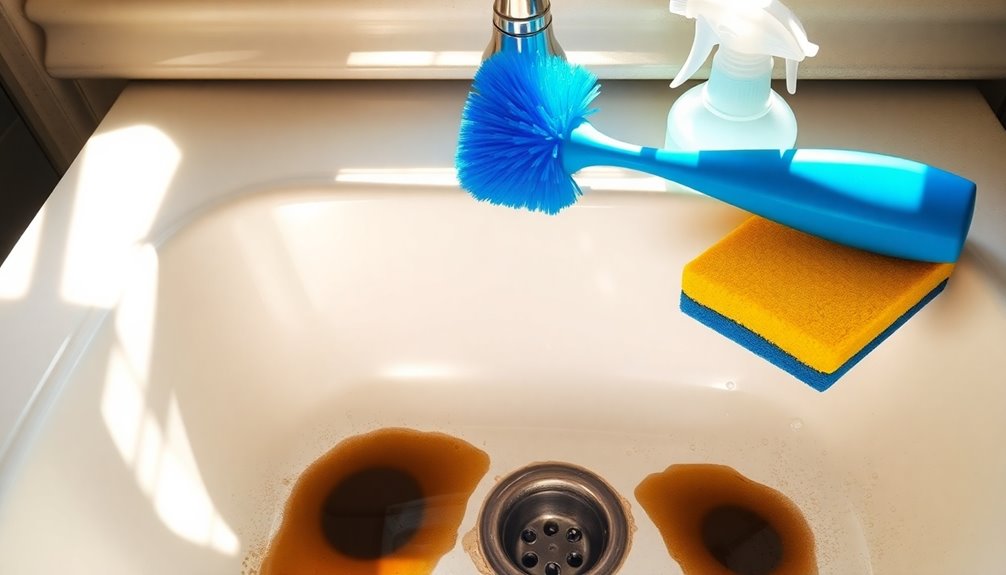
When you're facing tough stains in your utility sink, it's crucial to use the right scrubbing techniques and cleaning products.
Grab a razor blade scraper for stubborn residue and consider Bar Keepers Friend for rust spots.
With a bit of patience and effort, you can restore your sink to its former glory.
Effective Scrubbing Techniques
Tackle tough stains in your utility sink with effective scrubbing techniques that make the process easier and more efficient. Start by using a putty knife to gently scrape off excess dirt. Then, create a paste with Bar Keepers Friend Soft Cleanser and water, applying it to the stains and letting it sit for a few minutes. Scrub in a circular motion with 0000 grade steel wool to lift stains without scratching. For stubborn issues like paint or rust, consider a razor blade scraper or Bar Keepers Friend Powdered Cleanser. Don't forget to rinse the sink between different cleaning products to enhance effectiveness.
| Stain Type | Scrubbing Technique |
|---|---|
| Dirt | Putty knife for scraping |
| Tough Stains | Bar Keepers Friend paste, 0000 steel wool |
| Paint | Razor blade scraper |
| Rust | Bar Keepers Friend Powdered Cleanser |
| General Cleaning | Rinse thoroughly between products |
Recommended Cleaning Products
For a sparkling utility sink that's free of stubborn stains, choosing the right cleaning products is crucial.
Start with Bar Keepers Friend, a go-to for tackling tough stains on utility sinks. Its effective stain-lifting formula combined with gentle abrasives makes it perfect for stainless steel surfaces.
You can also whip up a natural cleaning paste using baking soda and liquid soap to safely remove grime without harsh chemicals.
For those pesky paint residues, consider using paint thinner, but make sure your space is well-ventilated and avoid mixing it with other cleaners.
Don't forget steel wool pads (0000 grade) for scrubbing, and a putty knife to scrape off hardened debris before you start cleaning for maximum efficiency.
Maintenance Tips for Longevity
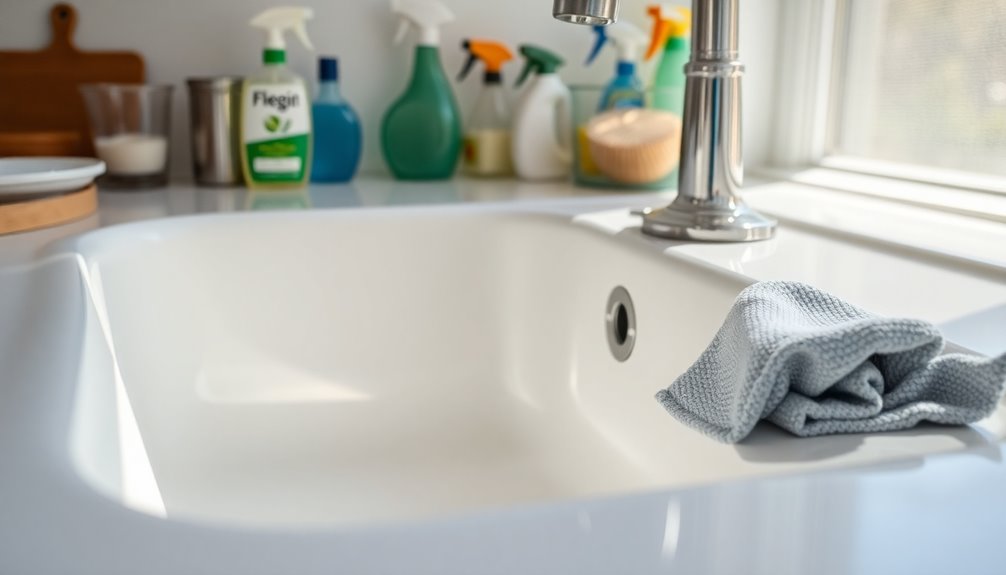
To guarantee your utility sink remains in top condition for years to come, regular maintenance is essential.
Clean your sink at least once a month using mild detergent and baking soda to prevent the buildup of grime and stains. After each use, wipe down the sink with a cloth to remove spills, which minimizes the need for deep cleaning sessions.
Employ a sink strainer to catch debris and avoid clogs that can lead to costly plumbing repairs. Be cautious with cleaning products; steer clear of harsh chemicals or abrasive cleaners, as they can damage the sink's surface and reduce its longevity.
Finally, inspect for plumbing issues like slow drainage or leaks and address them immediately to maintain ideal functionality.
Natural Cleaning Alternatives
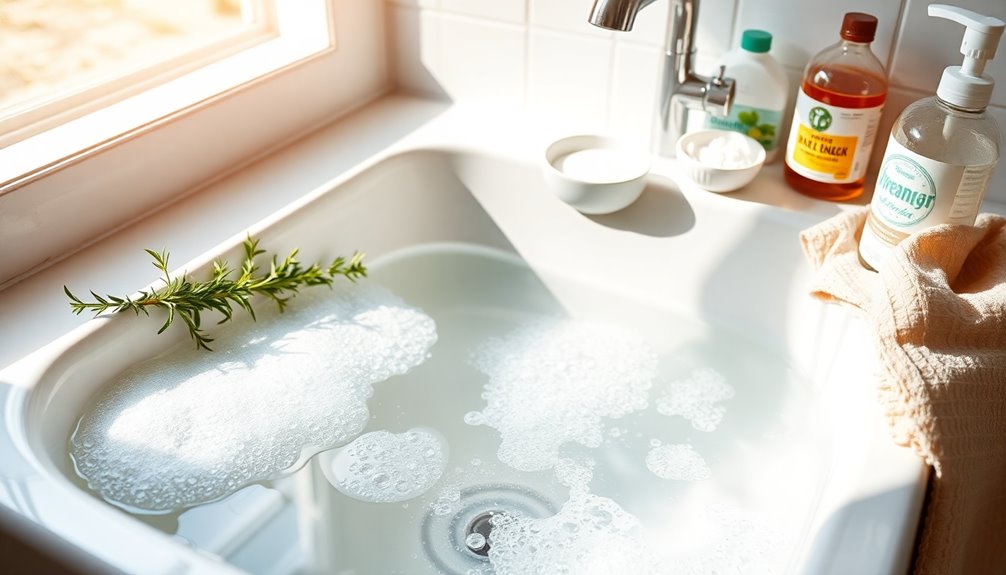
While many commercial cleaners contain harsh chemicals that can harm both your sink and the environment, natural cleaning alternatives offer effective and safe solutions for maintaining your utility sink.
Here are some options you can use:
- Baking Soda: Sprinkle it on stains to remove grime without harsh chemicals.
- Vinegar: Use it as a natural disinfectant and deodorizer, especially when combined with baking soda to tackle soap scum.
- Borax: Mix it with water to create a paste for scrubbing tough stains and neutralizing odors.
- Essential Oils: Add tea tree or lemon oil to your cleaning solutions for their antibacterial properties and pleasant scents.
Regular use of these natural cleaning methods not only keeps your utility sink looking great but also prevents harmful bacteria and mildew buildup.
Community Engagement and Sharing Results

By sharing your utility sink cleaning experiences in online communities, you not only gain valuable tips but also inspire others to improve their own cleaning routines.
Engaging with groups on platforms like Facebook allows you to exchange effective cleaning methods and discover natural alternatives like baking soda and vinegar.
Documenting your progress with before and after photos can showcase the transformation and motivate others to tackle their own projects.
As you discuss specific products, such as Bar Keepers Friend, you'll find a wealth of knowledge that can enhance your cleaning efforts.
Additionally, sharing effective cleaning methods can foster a supportive environment where everyone learns from each other's experiences and successes.
This community engagement fosters camaraderie and support, encouraging everyone to share results and refine their routines for a cleaner, more functional utility sink.
Frequently Asked Questions
What Can I Use to Clean a Utility Sink?
You can use several effective cleaners for your utility sink.
Try Bar Keepers Friend Soft Cleanser for tough stains, or grab some baking soda for a natural approach.
If you've got stubborn grime, 0000 grade steel wool works wonders without scratching.
For paint stains, mineral spirits are handy, but make sure to ventilate the area.
You can also mix vinegar and baking soda for a powerful cleaning solution that deodorizes and unclogs drains effectively.
How to Restore a Plastic Utility Sink?
You'd think restoring a plastic utility sink would be a breeze, but it's more than just a quick rinse.
Start by clearing out debris and rinsing it with warm water.
Mix baking soda and vinegar for a natural paste, scrubbing away stains gently with a soft sponge.
For stubborn grime, use a non-abrasive cleaner.
Don't forget to dry it off afterward to keep it looking sharp and check for any damage needing repair.
What Is the Best Cleaner for a Fiberglass Sink?
The best cleaner for a fiberglass sink often combines natural options like baking soda and Borax, which tackle tough stains effectively.
For stubborn marks, you can use mineral spirits, but remember to do so in a well-ventilated area and avoid mixing it with other cleaners.
Bar Keepers Friend is also a great choice, as it contains mild abrasives that help remove stains and restore shine without damaging the surface.
Regular maintenance will keep your sink looking great!
How Do You Clean a White Plastic Sink?
To clean a white plastic sink, start by removing any debris and rinsing it with warm water.
Mix baking soda and vinegar for a natural cleaning solution; the baking soda gently scrubs while vinegar tackles stains.
For tougher spots, apply a paste of baking soda and water, letting it sit for 10-15 minutes before scrubbing.
Rinse thoroughly with warm water and dry with a soft cloth to avoid water spots.
Avoid harsh chemicals!
Conclusion
In conclusion, keeping your utility sink clean isn't just about appearances; it plays an essential role in maintaining hygiene in your home. Did you know that a dirty sink can harbor over 500,000 bacteria per square inch? By following the cleaning tips we've shared and using natural alternatives, you can guarantee your sink stays fresh and safe. So, roll up your sleeves, tackle those stains, and enjoy a cleaner, healthier space for all your utility needs!
